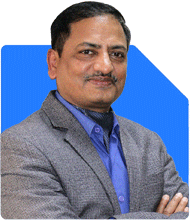38 yr old, 1.7L pm, how to achieve: House, 30L education, 2L monthly at 53?
Ramalingam Kalirajan |10893 Answers |Ask -Follow
Mutual Funds, Financial Planning Expert - Answered on Aug 08, 2024
He has an MBA in finance from the University of Madras and is a certified financial planner.
He is the director and chief financial planner at Holistic Investment, a Chennai-based firm that offers financial planning and wealth management advice.... more

My age is 38 male married and have one son age 7 years, earning 1.7 lac per month. 7 lacs in mutual fund, 25 lacs in PF, 7 lacs in NPS, real estate is 45 lacs and 7 lakh cash In hand . Help me to achieve three goals 1)I need to buy one 2 bhk (~80 lakhs) flat down payment amount adjustment immediately. 2) my kids education atleast 30 lakhs 3) Retire at the age of 53 with how much curpus I should build to get monthly income of 2 lakhs
Goal 1: Down Payment for a 2BHK Flat
You plan to purchase a 2BHK flat priced at approximately Rs. 80 lakhs. The immediate challenge is arranging the down payment.
Down Payment Requirement: Typically, the down payment is around 20% of the property’s value, which would be Rs. 16-20 lakhs. With Rs. 7 lakhs available in cash, you’ll need an additional Rs. 9-13 lakhs.
Asset Utilization: Consider liquidating some of your mutual fund investments to cover part of the down payment. Although selling investments might seem counterproductive, securing your home purchase takes priority.
Short-Term Loan Option: If you face a shortfall, a short-term personal loan could help bridge the gap. Ensure that this loan is manageable and plan to repay it quickly to avoid long-term financial strain.
Retain Real Estate Asset: While you may be tempted to sell your Rs. 45 lakh property to fund the down payment, retaining it is advisable. Real estate can appreciate over time and act as a financial safety net or source of rental income in the future.
Emergency Fund Consideration: Ensure that after making the down payment, you still have a sufficient emergency fund. Aim to keep at least 6 months of expenses in liquid assets.
Goal 2: Education Fund for Your Son
Your goal is to save Rs. 30 lakhs for your son’s education. Since your son is currently 7 years old, you have about 10-15 years to build this corpus.
Systematic Investment Plan (SIP): Continue and, if possible, increase your SIP contributions. An increased SIP will help in accumulating the education fund over time, leveraging the power of compounding.
Diversified Portfolio: Investing in a diversified mix of large-cap, mid-cap, and sectoral funds can provide a good balance of risk and growth potential. Avoid putting all your money in one type of fund to reduce risk.
Separate Education Fund: Consider setting up a dedicated education fund to ensure that these savings are not used for other purposes. This fund can be built using child-specific plans or targeted mutual funds aimed at education goals.
Periodic Review: Regularly review and adjust your investments based on market conditions and your son’s education timeline. If you notice any shortfalls or better opportunities, make the necessary adjustments.
Consider Inflation: Education costs are likely to rise due to inflation. Factor this in when planning your Rs. 30 lakh goal. You may need to increase your target to Rs. 40-50 lakhs to account for future inflation.
Goal 3: Retirement at Age 53
You aim to retire at 53 and need a retirement corpus that can provide a monthly income of Rs. 2 lakhs. With inflation, this requirement will increase by the time you retire.
Inflation-Adjusted Income: If we assume an inflation rate of 6%, Rs. 2 lakhs today will equate to approximately Rs. 4.5-5 lakhs monthly in 15 years. Your retirement corpus needs to be large enough to generate this income.
Estimated Corpus: To generate Rs. 4.5-5 lakhs per month, you’ll need a retirement corpus of around Rs. 10-12 crores. This estimate assumes a safe withdrawal rate and a balanced investment strategy during retirement.
Current Investments: You currently have Rs. 25 lakhs in PF, Rs. 7 lakhs in NPS, and Rs. 7 lakhs in mutual funds. Continue contributing to these, particularly to NPS and PF, as they offer tax benefits and steady growth. Increasing your contributions as your income rises will help you reach your goal.
Enhanced SIP Contributions: To build your retirement corpus, consider increasing your SIP contributions as your financial situation allows. Higher contributions now will lead to greater growth through compounding.
Diversification and Growth: Your retirement portfolio should be diversified across equity, debt, and hybrid funds. This approach provides both growth and stability, reducing the risk of market fluctuations affecting your retirement plans.
Debt Clearance: You currently have Rs. 8 lakhs in outstanding loans. Prioritize clearing these debts before retirement. Reducing your liabilities will lower your financial stress and allow you to focus on saving for retirement.
Health and Insurance Considerations: Ensure that you have adequate health coverage and life insurance during your retirement years. Consider increasing your health coverage to safeguard against rising medical costs. Review your life insurance to ensure it provides for your family if something happens to you.
Regular Financial Reviews: Review your retirement plan every 2-3 years. Adjust your investments and strategies based on changes in your financial situation, market conditions, and retirement timeline.
Investment Strategy and Asset Allocation
To achieve all three goals, your investment strategy needs to be aligned with each goal’s timeline and risk profile:
Short-Term Goal (Down Payment): Focus on liquid assets like mutual funds and savings for the down payment. Avoid taking on excessive debt.
Medium-Term Goal (Education Fund): Continue with SIPs in diversified equity funds. This balances growth and risk over a 10-15 year period.
Long-Term Goal (Retirement): Prioritize NPS, PF, and SIPs in equity and hybrid funds. These provide growth and stability over the next 15 years.
Emergency Fund Maintenance: Always maintain an emergency fund equal to 6-12 months of expenses. This ensures that unexpected events don’t derail your financial plan.
Final Insights
Your financial goals are ambitious but achievable with careful planning. For the flat purchase, consider liquidating some mutual funds and, if necessary, taking a small loan. Ensure that this does not impact your long-term financial stability. For your son’s education, focus on systematic investments and inflation adjustments to reach your Rs. 30 lakh goal. Lastly, to retire comfortably at 53 with a monthly income of Rs. 2 lakhs (inflation-adjusted), aim for a retirement corpus of Rs. 10-12 crores. Increasing your SIPs, paying off existing loans, and maintaining a diversified portfolio are crucial steps toward this goal. Regular reviews with a Certified Financial Planner can help you stay on track.
Best Regards,
K. Ramalingam, MBA, CFP,
Chief Financial Planner,
www.holisticinvestment.in
You may like to see similar questions and answers below
Sanjeev Govila | Answer |Ask -Follow
Financial Planner - Answered on Feb 05, 2024
Ramalingam Kalirajan |10893 Answers |Ask -Follow
Mutual Funds, Financial Planning Expert - Answered on Aug 21, 2024
Ramalingam Kalirajan |10893 Answers |Ask -Follow
Mutual Funds, Financial Planning Expert - Answered on Jul 17, 2024
Ramalingam Kalirajan |10893 Answers |Ask -Follow
Mutual Funds, Financial Planning Expert - Answered on Jul 10, 2025
Ramalingam Kalirajan |10893 Answers |Ask -Follow
Mutual Funds, Financial Planning Expert - Answered on Aug 04, 2025
Ramalingam Kalirajan |10893 Answers |Ask -Follow
Mutual Funds, Financial Planning Expert - Answered on Dec 15, 2025
Ramalingam Kalirajan |10893 Answers |Ask -Follow
Mutual Funds, Financial Planning Expert - Answered on Dec 15, 2025
Radheshyam Zanwar |6746 Answers |Ask -Follow
MHT-CET, IIT-JEE, NEET-UG Expert - Answered on Dec 15, 2025
Ramalingam Kalirajan |10893 Answers |Ask -Follow
Mutual Funds, Financial Planning Expert - Answered on Dec 15, 2025
Ramalingam Kalirajan |10893 Answers |Ask -Follow
Mutual Funds, Financial Planning Expert - Answered on Dec 15, 2025
Ramalingam Kalirajan |10893 Answers |Ask -Follow
Mutual Funds, Financial Planning Expert - Answered on Dec 15, 2025
Samraat Jadhav |2508 Answers |Ask -Follow
Stock Market Expert - Answered on Dec 15, 2025
Ramalingam Kalirajan |10893 Answers |Ask -Follow
Mutual Funds, Financial Planning Expert - Answered on Dec 15, 2025
Reetika Sharma |425 Answers |Ask -Follow
Financial Planner, MF and Insurance Expert - Answered on Dec 15, 2025
Radheshyam Zanwar |6746 Answers |Ask -Follow
MHT-CET, IIT-JEE, NEET-UG Expert - Answered on Dec 15, 2025



























